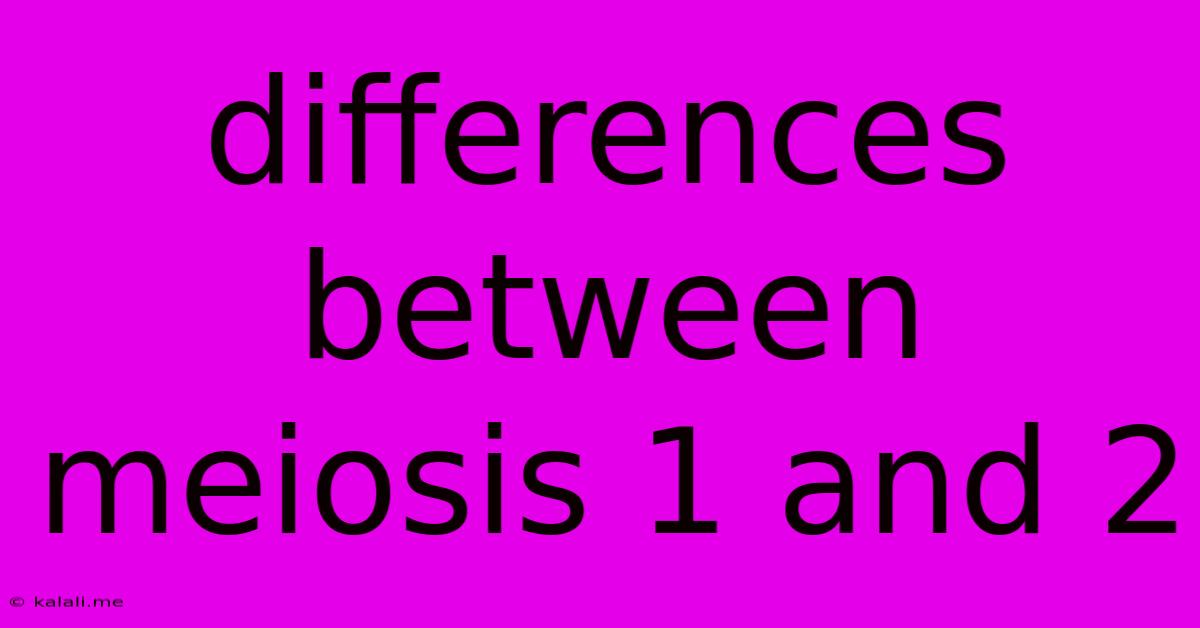Differences Between Meiosis 1 And 2
Kalali
May 09, 2025 · 3 min read

Table of Contents
Meiosis I vs. Meiosis II: A Detailed Comparison
Meiosis is a specialized type of cell division that reduces the chromosome number by half, creating four haploid cells from a single diploid cell. This process is crucial for sexual reproduction, ensuring that offspring inherit a combination of genetic material from both parents. Meiosis is divided into two distinct phases: Meiosis I and Meiosis II. While both phases involve a series of intricate steps, several key differences set them apart. Understanding these differences is essential to grasping the fundamental mechanisms of sexual reproduction and genetic variation.
Understanding the Big Picture: Why Two Divisions?
The primary goal of meiosis is to reduce the chromosome number from diploid (2n) to haploid (n). This is achieved through two successive divisions. Meiosis I is a reductional division, halving the chromosome number. Meiosis II, on the other hand, is an equational division, similar to mitosis, separating sister chromatids. This two-step process ensures genetic diversity and maintains a constant chromosome number across generations.
Meiosis I: The Reductional Division
Meiosis I is characterized by several unique events that distinguish it from Meiosis II and mitosis:
1. Prophase I: The Longest and Most Complex Stage
- Synapsis and Crossing Over: Homologous chromosomes pair up, a process called synapsis, forming a tetrad (bivalent). Crucially, crossing over occurs during this stage, exchanging genetic material between non-sister chromatids. This recombination event is a major source of genetic variation.
- Chiasmata: The points where crossing over occurs are visible as chiasmata. These physical connections between homologous chromosomes hold the tetrads together.
- Nuclear Envelope Breakdown: Similar to mitosis, the nuclear envelope breaks down, allowing for chromosome movement.
2. Metaphase I: Homologous Chromosomes Align
- Independent Assortment: Homologous chromosome pairs align randomly at the metaphase plate. This independent assortment of chromosomes is another significant source of genetic variation, resulting in different combinations of maternal and paternal chromosomes in the daughter cells.
3. Anaphase I: Homologous Chromosomes Separate
- Separation of Homologous Pairs: Unlike mitosis, where sister chromatids separate, in Anaphase I, homologous chromosomes separate and move to opposite poles of the cell. Sister chromatids remain attached at the centromere.
4. Telophase I and Cytokinesis:
- Haploid Cells Formed: Two haploid daughter cells are formed, each containing only one chromosome from each homologous pair. These cells are genetically different from each other and from the parent cell due to crossing over and independent assortment.
Meiosis II: The Equational Division
Meiosis II closely resembles mitosis in its mechanics, though it operates on haploid cells.
1. Prophase II: The chromosomes condense again if they decondensed during telophase I. The nuclear envelope breaks down (if it reformed).
2. Metaphase II: Individual chromosomes align at the metaphase plate, similar to mitosis.
3. Anaphase II: Sister chromatids separate and move to opposite poles.
4. Telophase II and Cytokinesis: Four haploid daughter cells are produced. These cells are genetically distinct from each other and the original diploid parent cell.
Key Differences Summarized:
| Feature | Meiosis I | Meiosis II |
|---|---|---|
| Chromosome Number | Reduces chromosome number from 2n to n | Maintains chromosome number at n |
| Homologous Chromosomes | Separate | Do not separate |
| Sister Chromatids | Remain attached in Anaphase I | Separate in Anaphase II |
| Crossing Over | Occurs in Prophase I | Does not occur |
| Independent Assortment | Occurs in Metaphase I | Does not occur |
| Genetic Variation | High, due to crossing over & assortment | Low, only due to potential mutations |
Understanding the distinct features of Meiosis I and Meiosis II is fundamental to understanding the genetic mechanisms underlying sexual reproduction and the diversity of life. The reductional division of Meiosis I and the equational division of Meiosis II work in concert to ensure the accurate transmission of genetic information while generating the genetic variation essential for evolution.
Latest Posts
Latest Posts
-
What Is 60 Of 75 Of 60
May 09, 2025
-
What Is 12 7 Mm In Inches
May 09, 2025
-
29 Cm Is Equal To How Many Inches
May 09, 2025
-
Cuanto Es 88 Grados Fahrenheit En Centigrados
May 09, 2025
-
60 Is 40 Of What Number
May 09, 2025
Related Post
Thank you for visiting our website which covers about Differences Between Meiosis 1 And 2 . We hope the information provided has been useful to you. Feel free to contact us if you have any questions or need further assistance. See you next time and don't miss to bookmark.